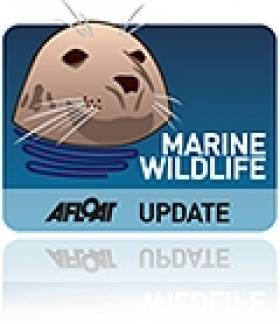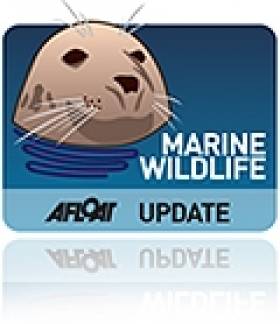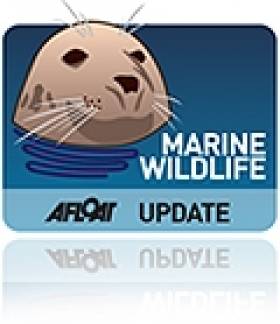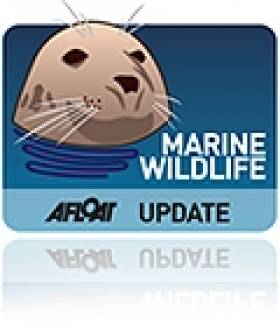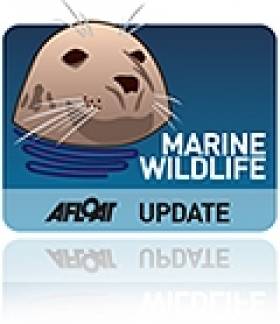Displaying items by tag: Irish Whale and Dolphin Group
'Unusual' Dolphin, Whale Strandings In Northwest
#MarineWildlife - Seven dolphins and two beaked whales have stranded on beaches in the northwest in events described as "unusual" by the Irish Whale and Dolphin Group (IWDG).
On the Mullet Peninsula, a group of seven common dolphins - comprising five adults and two juveniles - live stranded at Tarmon Beach on Sunday 12 May.
Though initial attempts to refloat them were successful, one of the juveniles was later found dead and the other was euthanised due to poor health.
Meanwhile in Donegal, the fresh carcass of a female True's or Sowerby's beaked whale was found on Sunday evening on Five Fingers Stand at Inishowen - some days after a reported live stranding of a Sowerby's beaked whale on the Welsh coast.
The Inishowen stranding was followed yesterday 14 May by the discovery of a dead beaked whale calf at Trawbreaga Bay, in what is believed to be a connected stranding.
Samples of the adult female were taken in order to confirm the species, either of which would mark a rare cetacean record for Ireland - the first since 2009.
#MarineWildlife - The Irish Whale and Dolphin Group (IWDG) is marking 20 years of researching the dolphins of the Shannon Estuary.
As the IWDG's Dr Simon Berrow relates, it was not an auspicious start on 2 May 1993 when the first research trip on the estuary returned after five hours without having seen a single cetacean.
But the following day brought a bounty, with 16 dolphins across three different groups located by the IWDG - the beginning of two decades of sightings and recordings for the Shannon Dolphin Project, which has identified around 230 individual dolphins to date.
Thanks to that project, we know today that at least six of those dolphins first seen in 1993 are still in the estuary as of last year.
The Shannon Dolphin Project now has a website explaining its achievements and the work of the Shannon Dolphin and Wildlife Foundation (SDWF) over the years.
Meanwhile, Afloat reader Karl Grabe has also produced a spectrogram and edit of hydrophone recordings captured by Dr Berrow of Shannon dolphins just a few weeks ago.
Grabe previously uploaded a wonderful snippet of dolphins vocalising in the estuary late last year.
Bunratty Dolphins Move On To Deeper Waters
#MarineWildlife - The trio of bottlenose dolphins who took up residence close to Bunratty Castle recently have apparently moved back out to deeper water after growing concerns for their well-being.
As previously reported on Afloat.ie, the dolphins had made their home opposite Durty Nellys pub in the Ratty River, which flows into the Shannon Estuary.
Simon Berrow of the Irish Whale and Dolphin Group (IWDG) explained that it's not unusual for dolphins to forage for food in waterways that feed into the estuary, though they usually return to the main catchment on their own shortly after.
With fears that their acoustic abilities were impaired, preventing them from navigating downstream past a series of bridges and concrete pillars between them and the main watercourse, a rescue attempt had been planned for late last week.
But as the Clare People reports, this was called off as the dolphins were spotted less and less frequently in the area.
Later hydrophone tracking by the IWDG led experts to discover that the cetaceans were able to come and go as they pleased.
Despite this, dolphins only have a limited ability to survive in fresh water, and can develop serious kidney and skin problems if exposed for a significant length of time.
Dolphin Trio At Home Near Famous Watering Hole
#MarineWildlife - Three bottlenose dolphins have made a new home close to a famous tourist watering hole in Co Clare.
According to the Irish Independent, the trio have taken up residence next to Durty Nellys pub in the Ratty River, which flows past Bunratty Castle into the Shannon Estuary.
The Irish Whale and Dolphin Group (IWDG), which has been tracking the group, believes they originated from a larger group populating the estuary.
As the IWDG's Simon Berrow explains, such dolphins are known to forage for food in rivers that feed into the estuary, and will return to the main catchment on their own.
While the risk of stranding in the shallower waters of rivers is unlikely, there is growing concern that the dolphins have been in the area for longer than expected.
"We can't rule out the possibility that their acoustic abilities may be impaired by the series of bridges and concrete pillars that span one of the bridges, and that they may be finding it difficult to navigate as a result of an 'acoustic trap'," says Berrow.
The IWDG says it is in discussion with the National Parks and Wildlife Service as to what options are available to step in to shepherd the trio back to the Shannon Estuary if necessary.
Brussels Wants Answers From State Over Seismic Surveys
#SeismicSurvey - The Irish Times reports that the European Commission has demanded an explanation from the State regarding the absence of environmental impact assessments for seismic surveys off the west coast.
The action comes following a complaint lodged in Brussels by the Irish Whale and Dolphin Group (IWDG) in the wake of the recommencing of seismic surveys over the Corrib gas field last month.
As Irish waters are a designated whale and dolphin sanctuary, the IWDG's position is that the State must comply with the EU directive to conduct an environmental impact assessment when licensing such ocean-bound surveys.
The group says it received word from the EC that the issue has been raised with the Department of Energy, and reiterated the need for "strict protection" of cetaceans in Irish and all EU waters.
Last December the IWDG expressed concerns over the potential impact of a 2D seismic survey on harbour porpoises in the Kish Bank Basin in Dublin Bay.
As previously reported on Afloat.ie, Providence Resources subsequently suspended its licence to explore for oil and gas at what was termed the Dalkey Island Prospect.
The Irish Times has more on the story HERE.
Humpback Surprises West Cork Over St Patrick's Weekend
#MarineWildlife - A juvenile humpback whale sighting off West Cork provided a St Patrick's weekend surprise for cetacean watchers.
Irish Whale and Dolphin Group (IWDG) sightings co-ordinator Pádraig Whooley writes on the discovery made off the Stags on the afternoon of Monday 18 March, which was verified by IWDG members Simon Duggan, Youen Yacob and Robbie Murphy.
Photo ID images captured at the scene allowed experts to confirm the whale is a newcomer to Irish waters, bringing the known total to 22 and continuing a growing trend.
Whooley also notes the unusual nature of the sighting, coming some months after the busy humpback whale activity in the area previously reported on Afloat.ie.
Those whales weren't seen again after that flurry of breaching and bubble-netting off Baltimore - presumably because being an older group, they were drawn south by their migratory instinct to the tropical feeding grounds.
In contrast, this likely juvenile - named Baltimore - may have opted to winter in higher latitudes to avoid competition with bigger counterparts, something that a group of humpbacks in the Norwegian fjords have also chosen to do this year.
The IWDG has more on the story HERE.
West Cork Weekends Will Bring You Closer To Marine Wildlife
#MarineWildlife - If you've ever wanted to get closer to Ireland's marine wildlife, a new series of weekend excursions in West Cork may be just the ticket.
The Southern Star reports on the 'Discover Wildlife Weekends' being run from Rosscarbery by local company Ireland's Wildlife starting this April, where those taking part will be led by expert guides to explore the coastal region and have the best opportunities to spot the many species of whales and dolphins that visit our shores.
Weather permitting, the weekends will also involve some offshore whale watching in the company of 'whale watch supremo' Colin Barnes and the Irish Whale and Dolphin Group's (IWDG) sightings co-ordinator Pádraig Whooley.
And birdwatching will also be a feature, as West Cork is a hotspot for our feathered friends - from merlins and peregrine falcons to coastal waders and more exotic fowl that skirt our coasts on their spring migrations.
The Southern Star has much more on the story HERE.
Meanwhile, marine sector stakeholders have expressed their concerns over the designation of six new offshore marine areas by the National Parks and Wildlife Service.
As previously reported on Afloat.ie, the six sites at Blackwater Bank in Wexford, the West Connacht coast, Hempton's Turbot Bank in Donegal, the Porcupine Bank Canyon off Kerry, the South-East Rockall Bank, and the stretch from Rockabill to Dalkey Island off Dublin have been proposed for designation as Special Areas of Conservation (SACs) to protect marine habitats and species listed on the 1992 EU Habitats Directive.
But at a recent meeting at the Irish Farm Centre in Dublin, a coalition of fish farmers, fishermen and marine energy stakeholders have hit out at what they characterise as "the appalling handling of inshore designations since the 1990s by the State", which they claim "has resulted in hundreds of job losses and a flight of serious investment" from Ireland's coastal areas.
“Our experience of the Irish Government’s application of the EU Habitats Directive has been a saga of mismanagement, foot dragging and buck-passing which has left over 500 fish farming licences in limbo for over 10 years and a backlog of red tape and bureaucracy which could see producers waiting until 2020 and beyond for simple renewals which are vital to underpin their businesses," said IFA aquaculture executive Richie Flynn.
"These new offshore SACs will have the same effect of preventing any fishing, marine energy or aquaculture being carried out in these areas if left in the hands of the same agencies to manage."
Recent Dolphin, Whale Strandings 'Very Unusual' Says IWDG
#MarineWildlife - The Irish Whale and Dolphin Group (IWDG) has described as "very unusual" a mass stranding of common dolphins on Achill Island last week - which was followed this week by the remains of cetaceans washed up in Kerry.
At least eight common dolphins were found dead on Keel Beach, Keem Beach and Dookinella on the Co Mayo island at the end of January.
And The Irish Times reports that two pilot whales and an "otherwise healthy" dolphin were found washed up at Cuas Croom near Cahirciveen in the last few days.
Commenting on the former incident, IWDG stranding officer Mick O'Connell said: "While there are occasionally live strandings involving groups of dolphins, it is very unusual in this country to see this number of dead dolphins washed ashore over a 10km area."
Strandings of deceased dolphins have also been reported in Donegal, and the IWDG's Simon Berrow suggests that the recent severe weather experienced around Ireland's coast may be a factor.
'Frontier' Surveyors Meet Sperm Whales and Killer Whale
#MarineWildlife - Sperm whales and a killer whale were among the finds on the last big effort of this year's Cetaceans on the Frontier survey led jointly by the Galway-Mayo Institute of Technology (GMIT) and the Irish Whale and Dolphin Group (IWDG).
As previously reported on Afloat.ie, marine scientists from GMIT's Marine and Freshwater Research Centre are on board the RV Celtic Explorer to carry out the fourth dedicated survey of cetaceans on the continental shelf edge.
The ship was surveying a zig-zag pattern in the Atlantic yesterday 2 February, some 55 nautical miles west-by-northwest of Achill Island (visible on this map HERE) when the team encountered at least two sperm whales, though an elusive third may also have been present - as indicated by the hydrophone being towed 200m behind the vessel.
"The blows continued and as we got closer, more and more body of the surfacing whale could be seen until we were treated to some reasonable views of the steep nose, long flat back and stumpy dorsal fin on initial surfacing followed by a thick tail stock with ‘knuckles’ seen when flaking," writes Niall Keogh on the Cetaceans on the Frontier blog.
Soon after that, the researchers were treated to their first sight of a killer whale in Irish waters - followed by a number of pilot whales surfacing close to the ship.
First Whales Of The Year Caught On Video
#MarineWildlife - Here's a little something cheerful to brighten up this chilly, snowy Monday morning: some video footage from YouTube shot by Irish Whale and Dolphin Group (IWDG) member Karl Grabe of the first whales to visit Ireland's shores in 2013.
As previously reported on Afloat.ie, the first sightings were made last week on the maiden member whale-watching trip on board the IWDG's new marine wildlife research vessel Celtic Mist off the coast of Wexford.
In addition to these fin whales, the group also made the acquaintance of a group of frolicking dolphins from the 'superpod' spotted in the Irish Sea recently, as you can see from the clip below:





























